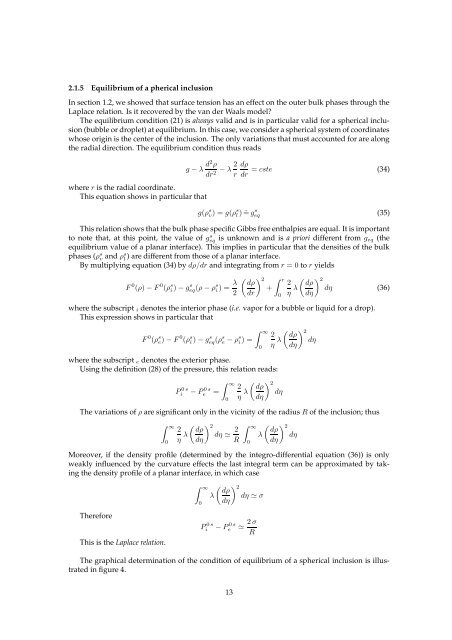Diffuse interface models in fluid mechanics
Diffuse interface models in fluid mechanics
Diffuse interface models in fluid mechanics
Create successful ePaper yourself
Turn your PDF publications into a flip-book with our unique Google optimized e-Paper software.
2.1.5 Equilibrium of a pherical <strong>in</strong>clusionIn section 1.2, we showed that surface tension has an effect on the outer bulk phases through theLaplace relation. Is it recovered by the van der Waals model?The equilibrium condition (21) is always valid and is <strong>in</strong> particular valid for a spherical <strong>in</strong>clusion(bubble or droplet) at equilibrium. In this case, we consider a spherical system of coord<strong>in</strong>ateswhose orig<strong>in</strong> is the center of the <strong>in</strong>clusion. The only variations that must accounted for are alongthe radial direction. The equilibrium condition thus readswhere r is the radial coord<strong>in</strong>ate.This equation shows <strong>in</strong> particular thatg − λ d2 ρdr 2 − λ 2 rdρ= cste (34)drg(ρ s v) = g(ρ s l ) ˆ= g s eq (35)This relation shows that the bulk phase specific Gibbs free enthalpies are equal. It is importantto note that, at this po<strong>in</strong>t, the value of geq s is unknown and is a priori different from g eq (theequilibrium value of a planar <strong><strong>in</strong>terface</strong>). This implies <strong>in</strong> particular that the densities of the bulkphases (ρ s v and ρs l) are different from those of a planar <strong><strong>in</strong>terface</strong>.By multiply<strong>in</strong>g equation (34) by dρ/dr and <strong>in</strong>tegrat<strong>in</strong>g from r = 0 to r yieldsF 0 (ρ) − F 0 (ρ s i ) − g s eq(ρ − ρ s i ) = λ 2( ) 2 ∫ dρr( ) 22 dρ+dr 0 η λ dη (36)dηwhere the subscript i denotes the <strong>in</strong>terior phase (i.e. vapor for a bubble or liquid for a drop).This expression shows <strong>in</strong> particular thatF 0 (ρ s e ) − F 0 (ρ s i ) − gs eq (ρs e − ρs i ) = ∫ ∞where the subscript e denotes the exterior phase.Us<strong>in</strong>g the def<strong>in</strong>ition (28) of the pressure, this relation reads:P 0 si∫ ∞( ) 2− Pe 0 s 2 dρ=0 η λ dηdη0( ) 22 dρη λ dηdηThe variations of ρ are significant only <strong>in</strong> the vic<strong>in</strong>ity of the radius R of the <strong>in</strong>clusion; thus∫ ∞0( ) 22 dρη λ dη ≃ 2 dη R∫ ∞0λ( ) 2 dρdηdηMoreover, if the density profile (determ<strong>in</strong>ed by the <strong>in</strong>tegro-differential equation (36)) is onlyweakly <strong>in</strong>fluenced by the curvature effects the last <strong>in</strong>tegral term can be approximated by tak<strong>in</strong>gthe density profile of a planar <strong><strong>in</strong>terface</strong>, <strong>in</strong> which caseThereforeThis is the Laplace relation.∫ ∞0λP 0 si( ) 2 dρdη ≃ σdη− P 0 se≃ 2 σRThe graphical determ<strong>in</strong>ation of the condition of equilibrium of a spherical <strong>in</strong>clusion is illustrated<strong>in</strong> figure 4.13











![[Diffusion-Limited Aggregation - A Model for Pattern Formation].](https://img.yumpu.com/52395246/1/190x245/diffusion-limited-aggregation-a-model-for-pattern-formation.jpg?quality=85)




